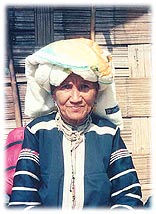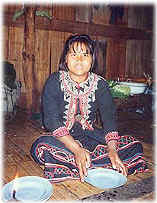The Lahu are
believed to have originated in Tibet and then migrated down to China, Laos, Burma and
Thailand. In Thailand most Lahu are located in Chiang Rai, Chiang Mai, Mae Hong Son and
Tak.
Lahu are divided into many subgroups: Lahu Nyi (Red Lahu), Lahu Na (Black Lahu), Lahu
Shehleh, Lahu Laba, Lahu Phu and Lahu Shi.
The Lahu Shehleh also call themselves Black Lahu but customs and dialect are different to
the Lahu Na.
The Lahu belong to the Tibeto-Burman linguistic group and amongst them, the dialect of the
Lahu Na is recognised as a standard; Lahu Nyi and Lahu Phu are closely related, Lahu
Shehleh is more divergent and Lahu Shi is the most different of all.
The Thai word for the Lahu is "Mussur", which means hunter and the Lahu are very
adept at hunting. Often in the dry season the Lahu men go into the forest to hunt for many
days at a time. |
 |
The Lahu Na and
Lahu Shehleh wear a lot of black. The women wear a knee length robe made from black
material and decorated with a white border and trimming, sometimes other colours are also
sewn in to the sleeves. They also wear black trousers and puttees. The Lahu Nyi wear a
short jacket usually blue, green or black with a large red border; they wear a sarong made
of the same colours. Lahu Shi wear a similar short jacket but in black and more intricate
and detailed applique design.
Clan and kinship doesn't play a large part in Lahu villages, although kinship will be
traced back through both mother and father when a couple decide to marry. In Lahu villages
the headman or the elders have most power and the rules of the village are decided through
consensus. Mobility of Lahu amongst villages is quite common and if they don't like the
rules of one village they find another which suits them better. This isn't a problem as
all Lahu think of other Lahu as brothers and sisters. |
 |
|